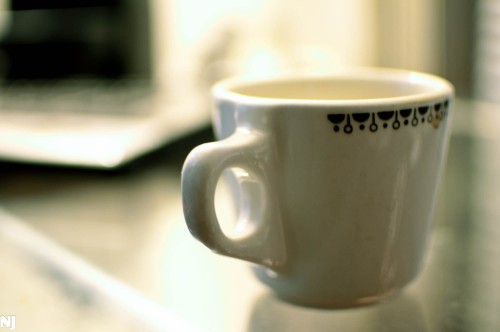
Stories In Focus, posted by Sarah Wahnecheck two days ago, is a brief exploration of Bokeh that strikes me as a great start to something bigger. This is just a quick followup, asking Sarah and others to think more about the reality that amateur, documentary and news footage is increasingly coming to look like art films, specifically the effect of having one thing in sharp focus with the rest blurred and out of focus.
In short, older video cameras that were used to film the news, make documentaries, cover war, protests and so on tended to keep much of the frame in focus. However, you probably have noticed another style of photography and videography where something is in sharp focus and the rest is blurry. The blur is often called “bokeh” and is achieved by using a wide “aperture,” which is the size of the opening of the lens that lets light in. To illustrate, hold your hand up about 12 inches from the front of your face. Focus on the details of your hand and notice how the rest of the world is a bit blurry. Shift your eye’s focus to the deep background and your hand goes out of focus. Natural bokeh. More expensive lenses on SLR and DSLR cameras can create this effect especially well. In fact, the tell-tale sign of a new photographer is the overuse of the one-thing-in-focus-everything-else-blurry photo-cliché. The effect cues the viewer (who is usually not a pro-photographer) that the photo was taken by a pro, even when the photo isn’t actually very interesting. For fun, to prove this, I just snapped the photo above of my coffee cup on my desk. It isn’t a good photo, but because it has one thing in focus and the rest is blurry (f/1.8), I’ll post it to Facebook and it will get a bunch “likes.”
This blur carries weight, imparts meaning, conveys status, and tells us that something of fiction was involved in creating the image rather than an attempt at capturing pure fact. Susan Sontag described every image as the product of both the poet and the scribe, of creative subjectivity and objective reality. And when we see a photo or video with lots of this bokeh effect, we know the emphasis is more on the poet. Looking at that coffee cup on my desk and then seeing it on the screen above are very different sights. I’m looking at the cup now, it hasn’t moved, and it’s pretty boring, however, the image suggests something a bit more artistic.
To this point, Sarah states,
Bokeh – and other visual styles – are the means by which we understand what kind of story we’re reading. They are the “once upon a time” that sets up our expectations of what we’re going to see.
What does it mean that more of this effect is showing up in the news? In documentary depictions of war and protest?
My first thought is to the ethical implications of video-journalists documenting the world as it appears versus creating something more artistic. Should the documentary videographer be required to depict the world as it appears to the eye? Should they try to keep as much in focus as possible to convey as much of the “truth” of scene as they can? I explore some of these issues surrounding the ethics of war-photographers using Hipstamatic and Instagram faux-vintage filters here.
What I’d most like to see expanded upon more has to do with the “once upon a time” feeling that videos in the exaggerated-bokeh-blur style suggest. Sarah rightly states that we have been trained to know that bokeh suggests dreamlike fiction, not cold reality. I’d like to ask: What does it mean that we present our protest to look like an art film? what does it mean that we present our news to look like fiction? and what does it mean that we present our war zones as picturesque?
I’d like to suggest that overly-bokeh’d news video exists to cast the confusing present in the soft glow of unreality. Be it the increasingly popular faux-vintage/Instagram/Wes-Anderson nostalgic glow or the “once upon a time” bokeh blur, we are trying to frame our confusing present as like the movies. ‘Today’ is always baffling, right and wrong are always in flux, heads are fuzzed-out in the epistemic-bokeh that comes with our postmodern condition. But with these effects, we can almost ascertain good and evil, winners and losers; by imbuing our news with the faded saturation of faux-vintage filters and warm bokeh glow, we can almost trick ourselves into believing the present as having the sharp focus of the big screen and of simpler times past.
Much more work needs to be done to support this thesis, I know. Hopefully this is something we can discuss more moving forward. In the meantime, see Sarah’s Original Post and the “In Praise of Bokeh” article she was responding to.

Comments 3
Apertures Matter (a brief response to ‘Stories In Focus’) « n a t h a n j u r g e n s o n — August 31, 2012
[...] This post originally appeared on Cyborgology – read and comment on the post here. [...]
War Games & War Stories: Part I – Black/white/gray all over » Cyborgology — October 4, 2012
[...] on the part of the general public. But documentation doesn’t equal a lack of mediation; it’s a form of meaning-making in and of itself, and it makes certain kinds of interpretation possible while precluding [...]
Dreams of Digital Death: Winstates and narrative limitations » Cyborgology — January 31, 2013
[...] what’s really possible. Our perceptions of what’s possible tend to be persistent; with visual media, there are certain assumptions coded within different forms, and when there’s a mismatch [...]